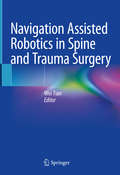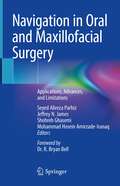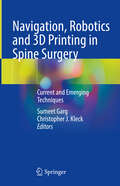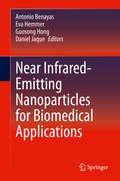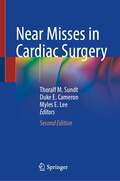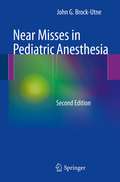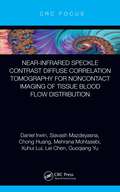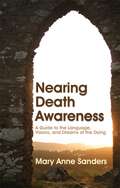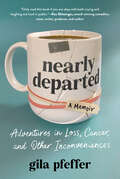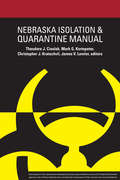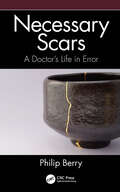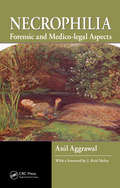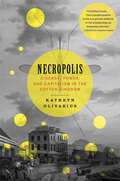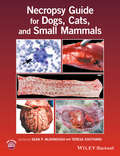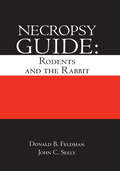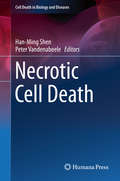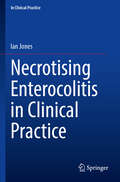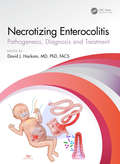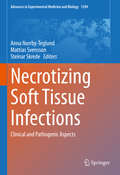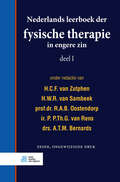- Table View
- List View
Navigation Assisted Robotics in Spine and Trauma Surgery
by Wei TianThe book introduces the using of navigation assisted robotic system in orthopedic surgery. The system is based on real-time 3D navigation. In the first part, it covers spine surgery, which includes pedicle screw fixation on cervical, thoracic, lumbar spine, dens screw fixation, Margerl screw fixation, PVP, PKP, and MED. The second part is about trauma surgery, which covers screw fixation in pelvis fracture and acetabulum fracture. This book is mainly written for spine surgeons, neurosurgeons, and traumatic orthopedic surgeons.
Navigation in Oral and Maxillofacial Surgery: Applications, Advances, and Limitations
by Mohammad Hosein Amirzade-Iranaq Shohreh Ghasemi Seyed Alireza Parhiz Jeffrey N. JamesThis book offers a comprehensive overview of the fundamentals of navigation surgery in the head and neck region. Navigation is particularly important in difficult and limited exposure areas, such as the orbit and deep spaces of the head and neck. With the aid of navigation systems, an expert can palpably and accurately measure the amount of bone removed during fracture reductions or resections of bony masses procedures. In addition to reducing surgery time for soft tissue lesions, navigation technique also allows for minimally invasive access to lesions without extensive dissection that is often required for traditional open approaches. Navigation can also be extremely helpful in locating and retrieving foreign bodies. Chapters cover navigation in a variety of different surgical specialties including, but not limited to, trauma surgery, implant surgery, and orthogenetic surgery. Chapters also discuss surgical pathology as well as guided surgeries. The book features detailed case presentations for each surgery sub-topic and discusses future advances in the field that are currently in development. Navigation in Oral & Maxillofacial Surgery is a must-have resource for clinicians, professionals, and practitioners in the fields of oral & maxillofacial surgery, otorhinolaryngology-head & neck surgery, trauma surgery, and plastic surgery, as well as researchers and postgraduate students in related fields.
Navigation, Robotics and 3D Printing in Spine Surgery: Current and Emerging Techniques
by Christopher J. Kleck Sumeet GargPresenting the most up-to-date, cutting --edge techniques and technologies, this book provides the reader with an overview of contemporary approaches for degenerative, deformity and minimally invasive spine surgery. Sensibly divided into four main sections, the opening chapter describes the history of spinal navigation and a brief summary of the current categories: imaging based navigation using optical systems; robotic navigation systems; and the use of 3D printed patient-specific navigation. Within each of these sections are chapters addressing patient positioning, surgical planning, specific technologies and instrumentation, and a summary of current clinical findings, with an eye toward best practices in planning and execution. A final section discusses additional considerations for these modalities, including economic and legal aspects of these procedures. Written and edited by thought leaders in the field of spine surgery, Navigation, Robotics and 3D Printing in Spine Surgery is designed for practicing spine surgeons and spine surgeons in training to help prepare them to safely and efficiently use navigation in spine surgery to optimize care for their patients.
Navy Doc on Her Christmas List
by Amy RuttanA snowbound reunion!Tension between Dr. Ella Lockwood and former navy doc Zac Davenport is sky-high! All she can think about is how he once broke her vulnerable heart.But now she’s a confident ER surgeon who’ll never let him hurt her again. And being snowed in together on Christmas Eve at Manhattan Mercy reveals his last tour of duty has changed Zac, too. But that compelling spark is still there—and one more irresistible kiss is all it takes to start healing the wounds that have held them back…
Near Human: Border Zones of Species, Life, and Belonging (Medical Anthropology)
by Mette N. SvendsenNear Human takes us into the borders of human and animal life. In the animal facility, fragile piglets substitute for humans who cannot be experimented on. In the neonatal intensive care unit, extremely premature infants prompt questions about whether they are too fragile to save or, if they survive, whether they will face a life of severe disability. Drawing on ethnographic fieldwork carried out on farms, in animal-based experimental science labs, and in hospitals, Mette N. Svendsen shows that practices of substitution redirect the question of "what it means" to be human to "what it takes" to be human. The near humanness of preterm infants and research piglets becomes an avenue to unravel how neonatal life is imagined, how societal belonging is evaluated, and how the Danish welfare state is forged. This courageous multi-sited and multi-species approach cracks open the complex ethical field of valuating life and making different kinds of pigs and different kinds of humans belong in Denmark.
Near Infrared-Emitting Nanoparticles for Biomedical Applications
by Daniel Jaque Antonio Benayas Eva Hemmer Guosong HongThis book analyzes and evaluates the growing field of light-emitting nanoprobes as contrast agents for in vivo imaging and sensing. It is a comprehensive resource that critically analyzes the state of the art in an interdisciplinary manner, with a special focus on the shift of emission wavelengths into the near-infrared (NIR) spectral region (ranging from 0.7 to 2 microns), which has greatly contributed to the latest advances in biomedical imaging and sensing. This book discusses merits of different contrast agents at nanoscale, and how their unique chemical and structural properties lead to the emission and interaction of light within the NIR window. Both the NIR-emitting materials and various surface modification strategies governing their interactions with the biological system at the “nano” level are discussed. Furthermore, different experimental techniques and protocols for NIR-light-based in vivo imaging and sensing are addressed to shed light on further understanding of the advantages and limitations of each category of these nanoprobes. Assembles the state of the art heretofore appearing in scientific literature into a comprehensive, multi-perspective guidebook on near infrared-emitting nanomaterials in an assortment of biomedical applications;Explains the physical, chemical, and biological phenomena underlying near infrared-emitting nanomaterials for biomedical applications;Presents conceptual and experimental approaches surrounding a unique spectral range of light emission from nanosized contrast agents, while offering a clear explanation of basic and general phenomena regarding the interaction between light and biological tissues, such as absorption, scattering and autofluorescence.
Near Misses in Cardiac Surgery
by Thoralf M. Sundt Duke E. Cameron Myles E. LeeThis heavily revised book features a variety of cases detailing potential complications in cardiac surgery. Clinical scenarios associated with conundrums and unforeseen circumstances are presented, including minimally invasive and hybrid procedures as well as temporary mechanical circulatory support. Discussions emphasize critical details in preoperative assessment and intraoperative sensemaking, decision making and error recovery. Chapters are structured as unknowns, presenting findings as one would experience the events clinically and challenging the reader to develop their own rescue strategies. Relevant references for further reading are included, enabling the reader to further develop their knowledge base.Near Misses in Cardiac Surgery is a concise case-based resource featuring instructions on how to deal with potential complications associated with cardiac surgery. The work's multi-disciplinary authorship ensures it is a valuable resource for all medical professionals involved in the care of cardiac surgical patients.
Near Misses in Pediatric Anesthesia
by John G. Brock-UtneAuthored by "a superb clinician and award-winning teacher,"* Near Misses in Pediatric Anesthesiology, Second Edition is a thorough updating and significant expansion of this popular case book in the newest anesthesiology subspecialty to be approved by the American Board of Medical Specialties. The book comprises 87 true-story clinical "near misses," including 40 cases that are brand new. Recommendations, references, and discussion accompany each case. The cases provide an ideal basis for problem-centered learning and also model how to learn from experience and to maintain professionalism during the lifelong development of clinical expertise. Dr. Brock-Utne's latest case book provides a pediatric complement to his bestselling Case Studies of Near Misses in Clinical Anesthesia (Springer, 2012) and Clinical Anesthesia: Near Misses and Lessons Learned (Springer, 2008) . * Jay B. Brodsky, MD, from the Foreword.
Near-infrared Speckle Contrast Diffuse Correlation Tomography for Noncontact Imaging of Tissue Blood Flow Distribution
by Lei Chen Daniel Irwin Siavash Mazdeyasna Chong Huang Mehrana Mohtasebi Xuhui Lui Guoqiang YuImaging of tissue blood flow (BF) distributions provides vital information for the diagnosis and therapeutic monitoring of various vascular diseases. The innovative near-infrared speckle contrast diffuse correlation tomography (scDCT) technique produces full 3D BF distributions. Many advanced features are provided over competing technologies including high sampling density, fast data acquisition, noninvasiveness, noncontact, affordability, portability, and translatability across varied subject sizes. The basic principle, instrumentation, and data analysis algorithms are presented in detail. The extensive applications are summarized such as imaging of cerebral BF (CBF) in mice, rat, and piglet animals with skull penetration into deep brain. Clinical human testing results are described by recovery of BF distributions on preterm infants (CBF) through incubator wall, and on sensitive burn tissues and mastectomy skin flaps without direct device-tissue interactions. Supporting activities outlined include integrated capability for acquiring surface curvature information, rapid 2D blood flow mapping, and optimizations via tissue-like phantoms and computer simulations. These applications and activities both highlight and guide the reader as to the expected abilities and limitations of scDCT for adapting into their own preclinical/clinical research, use in constrained environments (i.e., neonatal intensive care unit bedside), and use on vulnerable subjects and measurement sites.
Nearing Death Awareness: A Guide to the Language, Visions, and Dreams of the Dying
by Mary Anne SandersDying is a complex experience for the dying person and their family, friends, and carers, that involves all aspects of what it means to be human: physical, mental, and spiritual. The author describes different types of Nearing Death Awareness (NDA), including visions, dreams, and symbolic language, and offers practical guidance for family and carers of the dying about how to respond appropriately and supportively to NDA behavior. This sensitive and informative book will make fascinating reading not only for anyone who is likely to accompany a dying person, but for anyone with an interest in spirituality.
Nearly Departed: Adventures In Loss, Cancer, And Other Inconveniences
by Gila PfefferA sharp, funny, and heartfelt memoir of losing both parents to cancer and the daring choices Gila Pfeffer made to avoid the same early demise By the time she was thirty, Gila Pfeffer was the oldest living member of her family, having lost her mother to breast cancer and her father to colon cancer. A simple blood test confirmed she carried the BRCA1 gene—which put her at high risk of developing cancer herself. Determined to break the cycle of early death in her family, Gila decides to undergo an elective double mastectomy. This memoir follows her journey as she becomes a reluctant expert on how to sit shiva, grows up, falls in love, and enters motherhood, before her life is derailed yet again. Her double mastectomy reveals cancer already growing in one breast. After enduring eight rounds of chemo and the removal of her ovaries, she takes her last-ever dip in the mikvah waters as a bald, menopausal, thirty-five-year-old mother of four. With chutzpah honed over years of repeatedly surviving the worst, she manages to save her own life. Drenched in Gila’s dark humor, Nearly Departed is a story about thriving against the odds, committing to what’s important, and leaving a better legacy than the one you inherited.
NebenWirkungen: Über Halbgötter mit heruntergezogener Hose und andere Gesundheitsrisiken
by Ronny TekalLachen ist die beste Medizin. Dass Medizin aber auch ganz schön zum Lachen sein kann, beweist Dr. Ronny Tekal jede Woche aufs Neue, wenn er mit ärztlichem Insiderwissen in der Kolumne "NebenWirkungen" der ÄrzteWoche einen satirischen Blick auf die gar nicht so heile Welt der Heilkundigen wirft:Wer schon immer wissen wollte, was die "Halbgötter in Weiß“ mit den "Halbgöttern mit heruntergezogener Hose" verbindet, ob "Irren ärztlich ist" und Mediziner völlig hilflos sind, wenn sie „Datenlos durch die Nacht“ geistern, wie man seine „Farm im Darm“ bewirtschaften kann, statt sich im nikotinhaltigen „Nebel des Grauens“ zu verlieren, welche Größe der eigene „Medizinische Fußabdruck“ hat oder wo „Sankt Harvard“ liegt, wie man über die Partnerbörse „Tinder für Ärzte“ die idealen Behandler findet, wo sich im Spital die „Becher-Polonaise“ tanzen lässt und was die Ärzte unterm Kittel tragen, findet hier garantiert die passenden Antworten. Dieses Buch enthält die besten NebenWirkungen der vergangenen 10 Jahre. Für Ärzte. Und Patienten. Und alle, die das eine oder das andere einmal werden wollen.
Nebraska Isolation and Quarantine Manual
by Theodore J. Cieslak Mark Kortepeter Christopher Kratochvil James LawlerThe University of Nebraska Medical Center has gained international recognition for its expertise in the control and management of highly infectious diseases, with a good deal of public attention given to its work during the 2014 Ebola outbreak in west Africa and now in 2020 with its biocontainment and treatment of more than a dozen cruise ship evacuees who were exposed to the coronavirus. The Nebraska Isolation and Quarantine Manual is a practical guide for local public health officials, emergency management personnel, and health care providers looking to implement evidence-based best practices in the event of an infectious disease outbreak.
Necessary Conversations: Between Families and Their Aging Parents
by Gerald Kaufman L. Marlene KaufmanIn this timely book, long-time family counselors, Gerald and Marlene Kaufman, urge aging people, their adult children, family members, and other caretakers to talk directly with each other about the decisions that lie ahead as they age. "Do it before a crisis hits," say the Kaufmans. "A good time to start is when the parents retire."Necessary Conversations focuses on four primary areas:Parents' finances Parents' medical care Parents' living arrangements When to stop driving This honest and resourceful guide for aging adults and their family members includes helpful suggestions for starting these conversations and overcoming confrontation.
Necessary Scars: A Doctor's Life in Error
by Philip BerryWhether you are a doctor, nurse, student, or otherwise interested reader, the stories here will help you to understand how medicine works and how medical error can happen. The lifelong process of learning that is a medical career requires healthcare workers to find a way to live through these setbacks without either becoming too adept at putting them 'down to experience' and forgetting their social significance, or 'burning out' and leaving medicine. The stories and discussions here present detailed narratives, analyses, and reflections on medical errors through actions, omissions, and misunderstandings. They offer a uniquely honest perspective on the social implications of medical error and will enable healthcare workers at all levels to analyse and learn from it without losing sight of its impact.
Necrophilia: Forensic and Medico-legal Aspects
by Anil AggrawalNecrophilia: Forensic and Medico-legal Aspects is the first text that deals with the scientific aspects of necrophilia from a multidisciplinary point of view. After an introduction that provides a general scientific, social, and historical perspective, this volume:Explores causes and contributing factors, covering biological theories and genetics, as well as trauma, brain anomalies, and substance abuseOffers an original approach to classification, creating ten levels of severity from role playing to homicidal necrophiliaDiscusses necrophilia epidemiology, exploring offender characteristics and habitsProvides 20 case studies of infamous as well as less publicized casesDetails the forensics approach to necrophilia investigationExamines current legislation and mores across the worldExplains the challenges involved with providing expert testimony
Necropolis: Disease, Power, and Capitalism in the Cotton Kingdom
by Kathryn OlivariusDisease is thought to be a great leveler of humanity, but in antebellum New Orleans acquiring immunity from the scourge of yellow fever magnified the brutal inequities of slave-powered capitalism. Antebellum New Orleans sat at the heart of America’s slave and cotton kingdoms. It was also where yellow fever epidemics killed as many as 150,000 people during the nineteenth century. With little understanding of mosquito-borne viruses—and meager public health infrastructure—a person’s only protection against the scourge was to “get acclimated” by surviving the disease. About half of those who contracted yellow fever died. Repeated epidemics bolstered New Orleans’s strict racial hierarchy by introducing another hierarchy, what Kathryn Olivarius terms “immunocapital.” As this highly original analysis shows, white survivors could leverage their immunity as evidence that they had paid their biological dues and could then pursue economic and political advancement. For enslaved Blacks, the story was different. Immunity protected them from yellow fever, but as embodied capital, they saw the social and monetary value of their acclimation accrue to their white owners. Whereas immunity conferred opportunity and privilege on whites, it relegated enslaved people to the most grueling labor. The question of good health—who has it, who doesn’t, and why—is always in part political. Necropolis shows how powerful nineteenth-century white Orleanians—all allegedly immune—pushed this politics to the extreme. They constructed a society that capitalized mortal risk and equated perceived immunity with creditworthiness and reliability. Instead of trying to curb yellow fever through sanitation or quarantines, immune white Orleanians took advantage of the chaos disease caused. Immunological discrimination therefore became one more form of bias in a society premised on inequality, one more channel by which capital disciplined and divided the population.
Necropsy Guide for Dogs, Cats, and Small Mammals
by Sean P. Mcdonough Teresa SouthardNecropsy Guide for Dogs, Cats, and Small Mammals is a complete, practical resource for performing necropsies on dogs, cats, rabbits, rodents, and ferrets in the veterinary clinic, animal shelter, research laboratory, or in the field. Provides practical guidance on all aspects of performing an necropsy on dogs, cats, and small mammals and interpreting the results Presents more than 200 full-color images to demonstrate techniques and findings Offers step-by-step instructions for the necropsy process and collecting samples Includes an anatomy review, discussion of dissection techniques, and list of common artifacts and post-mortem changes for each organ system Supports veterinarians in performing a necropsy in any setting, including animal shelters, veterinary clinics, research laboratories, and in the field
Necropsy Guide: Rodents and the Rabbit
by Donald B. Feldman John Curtis SeelyThis laboratory guidebook provides step-by-step procedures that will aid in the dissection and collection of major organs and tissues of the most common species of small animals used in biomedical research. Through extensive use of photographs and illustrations, it guides dissectors through a complete necropsy of each species for the purpose of collecting organs and tissues routinely examined by pathologists. The techniques described enable technicians to perform necropsies on almost any mammal in a precise and logical sequence, and collect tissue properly to avoid diagnostic errors. Morphological differences among the various species are discussed.
Necrotic Cell Death
by Peter Vandenabeele Han-Ming ShenStarting with discussion of basic concepts and the molecular mechanisms of necrosis, this book looks first at several forms of necrotic cell death that have been identified, including necroptosis, autophagic cell death, and PARP-mediated cell death. As necrotic cell death is increasingly known to play a critical role in many physiological processes, the next chapters discuss its effect on metabolism, inflammation, immunity, and development. Necrotic cell death is closely implicated in human diseases like cancer, so the next chapters examine its relevance to human diseases, and final chapters cover methodologies for measuring necrosis. This book presents comprehensive coverage of necrosis from recognized experts from leading academic and medical institutions around the world. In contrast to apoptosis, well-defined as a form of programmed cell death, necrosis used to be considered as accidental (i. e. , non-programmed) cell death, usually in response to a severe injury. Accumulating evidence now suggests, however, that necrosis is also programmed and controlled by distinctive "death machinery" in response to various stimuli like oxidative stress or DNA damage.
Necrotising Enterocolitis in Clinical Practice (In Clinical Practice)
by Ian JonesThere is a very large body of literature on Necrotising Enterocolitis (NEC), much of it is confusing and contradictory. This book consolidates all the relevant aspects to provide clinicians and especially trainees with an overview of this condition which informs clinical practice and aids critical appraisal of new research in this area. The topic of NEC is often a single chapter in a paediatric surgical or neonatology text. This book is an invaluable guide for anyone caring for neonates.
Necrotizing Enterocolitis: pathogenesis, diagnosis and treatment
by David HackamThis is the first textbook devoted entirely to understanding and treating necrotizing enterocolitis (NEC), one of the leading causes of death and disability in premature infants. NEC continues to occur in neonatal units across the world, and the overall mortality has remained stubbornly high since its first description decades ago. Despite significant research into NEC, and a greater understanding of its underlying causes, there is no single source of information to which the care team can turn for guidance. This book fills that important gap in clinical care. In selecting the topics for this inaugural textbook, three guiding principles have been followed. First, to include chapters that provide detailed information for the medical team – the doctors and nurses, the therapists and pharmacists, the chaplains and the child life workers – so that each team member can optimally recognize, prevent and treat patients with this disease. Second, to ensure that chapters cover the depth and breadth of the latest clinical and scientific research into NEC, each selected to identify specific preventative strategies or therapies for this disease. Third, and perhaps most importantly, to focus not only on the child with NEC, but also on the child’s family, in order to provide comprehensive information about a disease that families have barely heard about, until the jarring day when their precious infant is affected by it. This book therefore: serves as a "how-to guide" for the care of the infant with NEC summarises critical new research and offers guidelines for future key research areas addresses the complex and difficult issues surrounding care of the critically ill infant suffering from NEC Written for the entire health care team including paediatric surgeons, neonatologists, developmental paediatricians, epidemiologists, ethicists, child life professionals, therapists and specialist nurses, each team member will find this book of value. This book was written to demystify this cruel disease, and to unlock its closely held secrets of pathogenesis, diagnosis, treatment and prevention.
Necrotizing Soft Tissue Infections: Clinical and Pathogenic Aspects (Advances in Experimental Medicine and Biology #1294)
by Anna Norrby-Teglund Mattias Svensson Steinar SkredeThis volume aims to enhance the current understanding of clinical features, treatment and pathogenic aspects in necrotizing soft tissue infections. Various representative case studies are discussed to enhance the readers’ understanding of these complex diseases. Necrotizing soft tissue infections are rapidly spreading infections that may cause extensive soft tissue or limb loss, multiorgan failure and are associated with a considerable fatality rate. It is undisputed that rapid diagnosis and prompt intervention is directly related to survival. The initial presentation may be limited to unspecific symptoms such as tenderness, swelling, erythema and pain. Thus, diagnosis and management are challenging due to heterogeneity in clinical presentation, in co-morbidities, in microbiological aetiology, as well as in the pathogenic mechanisms. An international and multidisciplinary consortium, INFECT, has for the last 6 years been pursuing research aimed to advance the understanding of the clinical and pathogenic aspects of these infections. A central part has been to create a comprehensive clinical registry and associated biobank which have also formed the basis for the experimental studies. Using the INFECT patient cohort, as well as an integrated systems biology approach in patients and clinically relevant experimental models, an advanced insight of diagnostic features, causative microbial agents, treatment strategies, and pathogenic mechanisms (host and bacterial disease traits and their underlying interaction network) has been obtained.
Nederlands leerboek der fysische therapie in engere zin deel I
by H.C.F. van Zutphen H.W.R. van Sambeek R.A.B. Oostendorp P.P.Th.G. van Rens A.T.M. BernardsDit deel 1 bevat een inleiding over fysiotherapeutische basisbegrippen en hoofdstukken over o.a. fysiologie en pathofysiologie van nocisensoriek, gelijkstroom- en hoogfrequentelektrotherapie.
Nederlands leerboek der fysische therapie in engere zin deel II
by H.C.F. van Zutphen H.W.R. van Sambeek R.A.B. Oostendorp P.P.Th.G. van Rens A.T.M. BernardsDit deel 2 bevat hoofdstukken over o.a. lichttherapie, lasertherapie, lokale thermotherapie, saunatherapie, hydrotherapie, ultrageluidtherapie en ultrafonoforese-therapie en veiligheid.
